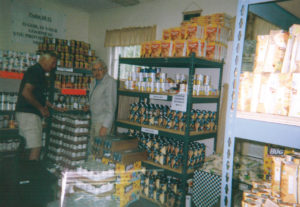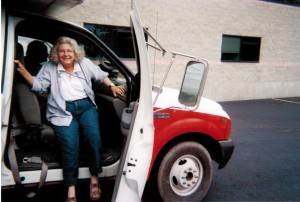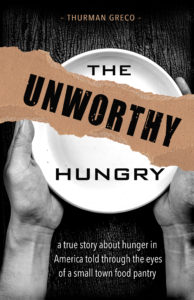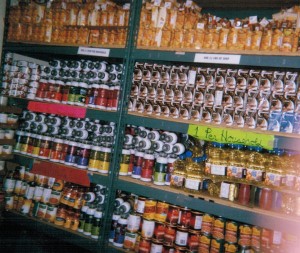It’s Vacation Time!

Your vacation time is here! It’s your last chance to get a break this summer. That means it’s time to go to the beach – to the mountains – to the city – ANYWHERE!
What do you have to do to get away? Well, first, find a place to go. Second, pack your bags.
FINALLY, drop off loads of food to your neighborhood food pantry before you take off on your vacation..
August is the most challenging month of the year for food pantries because it’s the month with the least amount of food available at the food bank. Food pantries get most of their food from donations and very few people donate in August. And, sadly, this carries right through to September. September brings school openings with parents getting ready for school lunches. Food pantries are often empty.
It’s my opinion that people don’t donate food to food pantries in August because they’re focused on their own activities: vacation, getting kids ready for school.
But, your neighborhood food pantry doesn’t have to be empty. There are things you can do. You can organize a food drive in your neighborhood and take the food to the food pantry. You can keep the food flowing right through to October.
Thank you in advance for thinking of things you can do for your food pantry during the leanest months of the year.
Please refer this article to your preferred social media network.
Thurman Greco

Are You Working On or Off?

A fairly common question I heard in the pantry line: “Are you working on or off?”
The first time I heard this question, I was confused. What did it mean? Actually, it referred to whether or not the person was paid in cash under the table or was paid money with withholding taken out.
Often the answer was something like: “I’ve got two days over at the food store and three days at Mrs. O……’s where I help her with her house and her office. I’m looking for a few more hours but it’s not happening.”
What this question asked was how many hours a person worked on the books and how many hours off the books. Not only was this practice illegal but it robbed workers of any benefit accrual and the opportunity to pay taxes.
Minimum wage paychecks simply don’t last a week. Individuals, families, entire households even can be employed and still live in poverty. My experience in the pantry was that more people in the pantry shopping line are employed than not.
I used to think of people as being employed or unemployed.
As I gained experience with the situation, I added another label: underemployed. So, rather than thinking in terms of employed or unemployed, I thought of hungry people in the line as being employed or underemployed.
I still see unemployed people but I realized many people aren’t paid a living wage.
I see shoppers where each person in the household works more than one job. The hope, dream, goal for many is simply to work enough hours and make enough money that a person can take a day off occasionally and have enough money to eat the following day.
People holding down more than one job often had trouble finding time to get to the Department of Social Services office to apply for SNAP (food stamps), although they might have qualified for the benefits.
Without a secure community safety net for the poor and destitute in our country, pantry volunteers needed to feed groceries weekly to families and households without money after they paid for rent and transportation to get to work.
Since the ’90s, many states have been “hell bent to Harry” to get people to work…no matter what. Welfare is no longer on the table.
A tip: Some people don’t realize our nation hasn’t offered much in the way of welfare in a long, long time. In polite conversation, I heard a statement: “That person shouldn’t be in your line. Her son has a job and she has a car.” I find it amazing that people in this country have been and continue to be comfortable denying assistance to the needy and destitute families while offering tax breaks to the wealthy.
My question was this: “How do people cope?”
Work first is not always a good option. I regularly saw pantry shoppers with family members who would be institutionalized if they weren’t being cared for by family. The institution is always the more expensive option.
The problem was that the family had nothing. So, while Helen or Sue or Fred was caring for the ill/disabled person, s/he wasn’t able to work.
Employment opportunities are a large part of the problem. People find themselves down and out in places with few job opportunities. Young people graduated from high school or college and can’t find a job anywhere.
Every economic downturn erases job opportunities. When the economy finally recovers, many jobs don’t return. Each recovery creates a class of citizens permanently living in the poverty of unemployment, underemployment, temporary employment, and day labor. Part time employment and being “on call” is a way of life.
The new group created after the downturn of 2008 had its own label: The Struggling Class.
Education costs are a factor. Fewer and fewer people can afford college or trade school. Some are afraid of the college loans they might not be able to pay off. One young woman in our food pantry line worked sixty hours weekly in low wage jobs to repay her college loan.
A fundamental attitude adjustment helped us realize food stamps, food pantries, soup kitchens, and shelters are no longer emergency concepts. They are the new way of life in the 21st century.
BEN
“I’m finished!” he blurted out. ” They fired me today!” I’ll never be able to get another job again. I’m too old!” Frightened reality covered his face when he entered the pantry for the first time. I didn’t say a word. I let him shout. He didn’t look or act as if he was going to hurt anyone and I felt he needed to release his anger.
I wanted his life to be easier than it was but what I wanted for him or any other shopper was nothing more than wishful thinking. There was little to nothing I could do. And, truthfully, I was helpless to do anything for him beyond offering a three-day-supply of food.
Every week after the first visit, he entered the pantry, shopped, and never made a sound. The mask of his face never changed.
Once the hair goes grey, it’s hard to compete in the market place. In a down economy, employers hire the younger applicants believing they’ll work harder for less money.
I hoped his unemployment would hold out until he could figure out how to get something more.
We all just left him alone. The pantry space was so small. It took him a year to calm down.
All we had was delicious, nutritious, food with a heavy emphasis on fresh vegetables and fruits. I relied on the food to make up for what we didn’t have.
I saw him recently – calm, maybe at peace with his situation. He lives in his truck, semi-homeless I suppose. He has places to bathe and sleep when he’s in Woodstock.
Woodstock attracts musicians. He’s one of those considered talented, this man. He’s found places to play around the area and he’s looking okay. What more can we all ask for anyway?
Thurman Greco
Thank you for reading this blog post. Please refer it to your favorite social media network.
Thurman
A new book is coming soon! Please be on the lookout for Miracles!
Thanks again!
9 Things You Can Do to Cut Out the Unhealthy Salt in Your Life So You Can Be Healthier

If being involved in a pantry does nothing else, it teaches us to be aware of the impact that salt has on our health. Getting too much salt, and getting the wrong salt, are two important things we need to learn about in order to be healthier.
An important ingredient in fast food is salt. Many canned soups we eat at home have unrealistically high amounts of salt. Salt is everywhere!
1. ADD CELERY TO YOUR MEALS WHENEVER YOU CAN. Sprinkle chopped celery on salads, soup, cooked vegetables, cooked meats. Be generous. Celery offers a crunch, and has potassium, something we all need. If you can get enough celery at the pantry, stuff it with peanut butter for a healthy meal or snack. If you suffer with hypertension, eat generous amounts of celery every day.
2. WHEN YOU MAKE SALADS WITH ONIONS, AND RADISHES, YOU WON’T MISS THE SALT AT ALL.
3. BE GENEROUS WITH PEPPER AND HERBS.
4. GO FOR EDIBLE FLOWERS. Experiment with herbs and flowrs on your salads: chives, dandelions, garlic, mint, nasturtiums, onions, violets.
5. CHOPPED FRESH GREEN BEANS ARE GOOD TASTE TREATS ON SOUPS, SALADS, VEGETABLES.
6. LOW SODIUM CANNED BEANS SUCH AS PINTOS, CHICKPEAS, BLACK, KIDNEY MAKE GOOD ADDITIONS TO SALADS, SOUPS, VEGETABLES.
7. MAKE YOUR OWN CROUTONS. Your homemade variety will be just as tasty if you rub the bread with garlic before preparation and then sprinkle them with herbs.
8. MAKE YOUR OWN SOUP. The best soups come without a label. What you prepare at home can have less fat, salt, sugar, MSG and preservatives. Substitute herbs.
9. SALAD DRESSING YOU MAKE AT HOME CAN BE MORE FLAVORFUL IF YOU CAN USE UNREFINED OILS. That way, you’ll get healthy fats, vitamins, and distinctive flavors.
Thank you for reading this blog.
Please share this article with your preferred social media network.
There will be more posts in the future about healthy eating and at least one will feature Real Salt, which I recommend. Hope you find them both fun and interesting.
Peace and food for all.
Thurman Greco

It’s a Miracle!
 This article was written back in 2013 when we got Miriam’s Well up and running. I’m sharing this event with you.
This article was written back in 2013 when we got Miriam’s Well up and running. I’m sharing this event with you.
Enjoy!
Lord,
When we drive Miriam’s Well up to the apartment complex, children gather round. Their mothers shop for food.
Lord, I’m so grateful for this truck. It took us exactly thirty-four minutes to design Miriam’s Well at the meeting in my healing space. It took us exactly two weeks to get her together. This truck is a miracle, Lord. When You work a miracle, You arrange for things to work perfectly. I love the perfection of this plan!
We put food in the back of Miriam’s Well, take it to Woodstock Commons, Woodstock Meadows, to the grounds at St. Gregory’s, and over to Tongore Pines, where the people come to shop.
There are no long lines, Lord. There are no waits. People just come to Miriam’s Well, get the groceries they need, visit with one another, and go home to wherever or whatever that is, with the food they need.
Dignity, smiles, positive thoughts, uplifting events. The whole scene is reminiscent of a time at a village well in a Bible story. That’s why we named her Miriam’s Well.
Only You could have done this Lord. You guided our hands, hearts, minds through the entire project.
How can we ever thank You enough Lord?
Amen
Thanks for reading this article!
Please refer this post to your favorite social media network.

 P S – The manuscript has gone to the publisher. I look forward to sharing this story with you in the coming weeks. Thanks so much for your interest!
P S – The manuscript has gone to the publisher. I look forward to sharing this story with you in the coming weeks. Thanks so much for your interest!
Thurman Greco
The Hunger Book is on the Editor’s Desk!

After what seems like eons, this hunger book is finally on the editor’s desk.
This book is long, complicated, and full of information focusing on a subject people know very little about – unless they live and/or work in it. Recently, on the advice of my editor, the book has been divided into three separate books.
Because of these changes, the hunger book will be easier to read and use.
With three volumes, we now have three titles:
“I Don’t Hang Out in Churches Anymore”
“The Unworthy Hungry”
“Hungry in America”
Of course, as a book progresses, things change and then they change again. So, whether it’ll have two sections or three, it’s true that the one volume was way too large.
I’m extremely excited about this project! Our goal for this project is to send the first volume to the publisher by mid-September.
Thank you for reading this blog. Please refer this article to your favorite social media network.
“A Healer’s Handbook” is now available! You can purchase it through Amazon, Barnes and Noble, and my website: http://www.thurmangreco.com.
Thanks!
Thurman Greco
My Story and the 9 Truths I Discovered
I began my life changing journey fighting hunger on a cool autumn Thursday in Woodstock, New York in 2005 where I volunteered for the first time at the local food pantry.
I was assigned a shift with Marie Duane. I drove over to the Woodstock Reformed Church, parked my car behind the buildling and cautiously walked in. I had never been to the pantry before.
I entered the empty hallway and found the pantry on the right. I walked into the room and there it was: a small space, actually, about 12′ by 16′. Each wall supported a set of metal shelving units. Each unit stood about 6′ high and 3′ deep with 4 shelves. Most of the shelves were empty. A few shelves had some food:
cereal
tuna
soup
peanut butter.
There was a little handwritten note in front of each display:
person: 1 item, family: 1 item.
There may have been other items on shelves but I don’t remember them.
A small table stood in the center of the room. A metal folding chair was placed in front of each window.
We sat in the chairs, Marie and I, and chatted as people trickled in. We discussed the usual: weather, gardening, knitting, decorating the alter at St. Gregory’s Episcopal Church.
“Hi. How are you? Will you please sign your name here?” Each shopper signed in and noted the number of adults, seniors, and children in the household. After signing in, the person walked around the room selecting from the cereal, peanut butter, tuna, and soup. The selected food was placed on the table and bagged to take home, wherever or whatever that was.
On this morning, not blessed with any psychic knowledge, I was totally unaware of experiences waiting for me in the pantry. Never in my wildest thoughts did I envision the hall filled with hungry people, the tiny room packed with fresh produce and jammed with shoppers.
Nor did I for 1 moment ponder the push back I would experience as the number of hungry seeking food grew. Within a few short years, this 2 dozen single homeless men – mostly Woodstock’s colorful characters – had swelled (due to a tanking economy) to over 300 people weekly. This number finally approached 500 people weekly before it was all over.
Now, in the autumn of 2015, our stock market experiences numerous “corrections”. I realize I learned some things over the years which, for me, are ground truths about the pantry.
Feeding the hungry with dignity is the most important thing.
Single homeless men are now far outnumbered by members of the Struggling Class, households of working people holding down 2 and 3 jobs just to pay the rent and buy the gas to get to work.
The 3 most hot button words in the English language are food, sex, and money. These 3 words are concerned with a person’s core beliefs, emotions, and spiritual attitudes. Food and money, or the lack thereof, loom large in pantries.
The sidewalks in our communities and cities have become wards of untreated mentally ill people. In our great nation we don’t hospitalize or otherwise treat many of our mentally ill. Instead, they they are incarcerated.
Some of these untreated mentally ill happen to be homeless. Homeless is not a category of people. It’s just a situation that happens. It can happen to anyone.
The 50+ senior population has many who lack enough $$$ for food and are largely a silent group. The bottom line is this: When our grandparents don’t get enough to eat, they often get sick.
I’m seeing a whole generation of children who have never been inside a grocery store.
Shoppers at our pantry can get a 3-day supply of food weekly. Their job is to make it last 7 days. Many share this food with a pet. Often, the only thing a person has left from a prosperous past is the dog.
The most difficult thing I see in the pantry is a Korean War vet getting food. Something I just can’t understand is how a person who served in a very brutal war, and subsequently spent an adult life working and paying taxes should have to be in a food pantry line in his old age.
Much of the food available to the hungry in food pantries is diverted from its trip to the landfill.
There is absolutely no excuse for anyone in our great nation to go hungry.
Thank you for reading this blog. The story is true. The people are real.
Please refer this article to your preferred social media network. Share this story with friends or relatives who might be interested.
Don’t forget to join the email list.
Thurman Greco
Is This Life Now?

The New York Times – Friday, February 27, 2015 – “Food Waste Grows with the Middle Class” – page A24
A recent New York Times Editorial highlighted the “massive food waste” around the world. I urge you to read it. It was extremely well written, as are all of the NYT editorials.
Containing all the right buzz words:
landfills,
hunger,
waste disposal,
global warming threat,
it just didn’t go far enough.
FOOD PANTRIES FEED THEIR CLIENTS SURPLUS FOOD INTERCEPTED ON ITS WAY TO THE LANDFILL. They simply no longer have the $$$ for food at the supermarket or they live in food deserts (neighborhoods where there are no grocery stores or supermarkets.)
Is this life now? Yes, this is life in 21st century America. This is not emergency food. This is the new way we live in the good old U S of A.
PEOPLE ARE OFTEN ASHAMED TO SHOP IN PANTRIES. They don’t want to be seen bringing pantry food home. They don’t want to explain to their friends, neighbors, relatives about their inability to buy food at the supermarket. Well, now they can move on past the shame and embarrassment. With this New York Times editorial, we can all see that hungry people lacking $$$ to purchase food at a grocery store are now a part of the solution instead of the problem.
Hungry people shopping at food pantries help fight food waste. Food pantry shoppers can now realize they are helping reduce global warming emissions.
People shopping at pantries are in a financial bind where they are forced to make trade-offs. They pay rent when they don’t have enough food to eat. They “heat or eat”.
Often, they make health care trade-offs. People unable to seek needed medical care are unable to make good choices. Eventually they’ll be forced to deal with the medical situation and the longer they wait, the more expensive the situation becomes. The healthcare $$$ has been diverted to rent or transportation to get to work.
Articles like the New York Times editorial make it difficult for citizens in our country to completely ignore the fact that more and more people are going without food in our great nation because they simply don’t have the $$$ to buy it. We can no longer deny that hunger exists and it is becoming more and more difficult to be indifferent about it.
So, now, with this editorial, those of us who are hungry and ashamed of the situation we are caught in can feel better about ourselves. We can now shop at the pantry and eat at the soup kitchen knowing that we are, in spite of the low wages we work for, doing our part for a healthy planet. We are fighting global warming. We are our tax dollars at work.
If you read this blog and feel you are among those who don’t have enough $$$ for food, now is a good time to begin to shop at a pantry for the food you need for your household.
There is no better time than now for you to not only support your community but also your planet.
See you at the pantry!
Thank you for reading this blog.
Please refer this article to your preferred social media network.
If you found this article a help, please leave your comments below and check out our other posts.
Don’t forget to join the email list.
Peace and food for all.
Thurman Greco






